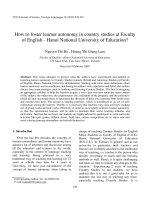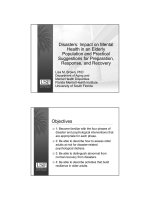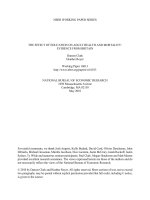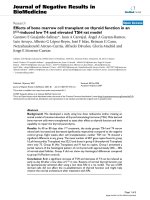The effect of literature response activities on student motivation in an american literature class at the Hanoi national university of education
Bạn đang xem bản rút gọn của tài liệu. Xem và tải ngay bản đầy đủ của tài liệu tại đây (147.29 KB, 9 trang )
JOURNAL OF SCIENCE OF HNUE
Interdisciplinary Science, 2013, Vol. 58, No. 5, pp. 150-158
This paper is available online at
THE EFFECT OF LITERATURE RESPONSE ACTIVITIES
ON STUDENT MOTIVATION IN AN AMERICAN LITERATURE CLASS
AT THE HANOI NATIONAL UNIVERSITY OF EDUCATION
Do Thi Phuong Mai
Faculty of English, Hanoi National University of Education
Abstract. The author investigated the effect of using literature response
activities when teaching American Literature to students who are majoring in
English language at the Hanoi National University of Education. One class of
English-major students studied American Literature in two phases. In phase 1 there
were no literature response activities and in phase 2 there were literature response
activities. It was seen that during the second phase, students were much more
motivated to learn American Literature than during the first phase. On the basis
of this observation, the author suggests some effective activities that teachers could
present when teaching American Literature to English-major students.
Keywords: Literature response activities, American literature, motivation.
1.
Introduction
English language teaching in Vietnam in recent years has moved from the traditional
approach to various versions of communicative approaches. Such has been the case in the
teaching of Literature to EFL students. In the traditional approach, a teacher would give a
lecture about a work of literature and give the students his interpretation of the content and
value of the book. It is now thought that this might not be the best method of teaching in
a language class. Consequently, a variety of other approaches and methods are now being
used. One is the use of literature response activities. However, few studies have been done
to show the usefulness of these activities in the classroom. Therefore, the author decided to
do this research in order to evaluate the effect of literature response activities in American
Literature classes on English–major student motivation at the Faculty of English, Hanoi
National University of Education.
Received May 19, 2012. Accepted January 2, 2013.
Contact Do Thi Phuong Mai, e-mail address:
150
The effect of literature response activities on student motivation in an American Literature class...
2.
2.1.
Content
Reader Response theory and Literature response activities
Reader response theory was first suggested by Rosenblatt (1938, [8;1978]). She
proposed a radical view of how people derive meaning from what they read. The key
features of her theory are the focus on readers’ psychological processes and literature
being a means of promoting critical thinking and an openness to multiple perspectives.
She believed that when experiencing literature, readers bring a wealth of emotion,
experience and personal knowledge which provokes associations with words, images and
ideas in the text. This in effect promotes open-mindedness, a foundation of democracy.
Rosenblatt also described how a reader’s response is both individually and socially
constructed. This accounts for the multiple and diverse responses within and between
readers. Teaching literature should therefore be a delicate balance between eliciting
personal responses from students and guiding their understanding of literary elements.
Based on Rosenblatt’s theory, researchers like Alice Hoffman (ny) and Sarah &
Michael Martin (2000) have developed a variety of literature response activities. The
followings are some of the most common activities [1]:
• Compare and contrast characters, two books or texts.
• Create an alternative ending.
• Create a book jacket.
• Write a letter to a character.
• Make a puzzle depicting a scene or a character.
• Create a crossword puzzle based on the story.
• Make a cartoon of your favorite scene or the entire story.
• Write a review.
• Create a scrapbook.
2.2.
Motivation
The term “motivation” comes from the Latin word ‘movere’ which means ‘to move’.
The idea of movement is reflected in different commonsense ideas about motivation as
something that keeps us working, gets us going and helps us complete tasks. Motivation
is a process rather than a product. Therefore we cannot observe it directly but we can infer
it from actions and verbalizations.
There are many definitions of motivation and abundant disagreement over its
precise nature. For this study, motivation is defined in the terms put forward by Crookes
and Schmidt (1992, [4;498- 502]) and quoted in Peacock (1997 [7]): interest in and
enthusiasm for the materials used in class, persistence with the language task as indicated
by the levels of attention or action for an extended duration and levels of concentration and
151
Do Thi Phuong Mai
enjoyment. The writer chose this definition as she agrees with them considering that the
long hours that students spend in the classroom would make such motivation an important
factor in the successful learning of a language. Moreover, Ushioda (1993, p.1-3) calls
this view of motivation “practitioner-validated” and adds that student participation and
enthusiasm are significant outcomes in themselves.
Generally, two kinds of motivation are distinguished, extrinsic and intrinsic
motivation.
Intrinsic motivation is motivation from within the student and it focuses on the
learning task itself. An intrinsically motivated students studies because he/she wants
to study. To have an intrinsically motivated learner is the goal of all motivational
development. Jeremy Harmer (1996, p.5) identified 4 factors that affect intrinsic
motivation in an EFL classroom. He listed them as the physical conditions (the
classroom, the board, etc.), the method (boring or interesting), the teacher (pronunciation,
explanation, patience, etc.) and success (success or failure).
Extrinsic motivation is, on the other hand, concerned with factors outside the
classroom such as student attitude about language learning, rewards and punishments.
Extrinsic motivation is divided into 3 sub-types of motivation: social motivation
(People’s desire to gain social approval from significant others), instrumental motivation
(People’s desire to be rewarded or to avoid being punished) and achievement motivation
(characterized by striving for high levels of performance in a competitive environment).
However, life is not so clear cut. The difference between intrinsic and extrinsic
motivation is not always sharp. In other words, people usually learn a language for
reasons which are an integration of both these two kinds of motivation (intrinsic as well
as extrinsic).
2.3.
Presentation of the course
The American Literature course was designed to be taken by fourth-year students
in their 7th semester in the eight-semester program. It was a fifteen-week course which
provided students with an overall view of American literature. They were to gain a
basic knowledge of different stages of its development, factors that have affected this
development, some major literary trends and some prominent American writers that could
represent different stages and trends in literature.
However, in this study, the researcher chose to analyze just 4 lessons and on this
basis he has drawn his conclusions.
1 Kate Chopin and her The Story of an Hour and Hemingway’s Cat in the Rain.
2 Bret Harte and his The Luck of the Roaring Camp and Jack London with The Law
of Life.
Of each pair of books, the latter was taught with the use of literature response
activities while the other was not. In this way the change in student’s motivation could be
152
The effect of literature response activities on student motivation in an American Literature class...
measured when literature response activities were used.
2.4.
Method
In carrying out this research. the writer used the following research instruments:
Observation
An observation sheet (cf. [7]) was used to assess overall class motivation generated
by the tasks as manifested by level of student interest, enthusiasm, persistence with the
learning task, concentration, and enjoyment during class as measured rating 8 items. This
observation sheet was used in Peacock’s 1997 study. Each item in this sheet was scored
using an artificial materials scale of one (low) to five (high). The maximum possible score
is 40. The class was observed by a trained colleague on four occasions, two during which
using literature response activities were being used and and two during which literature
response activities were not being used. The observation sheet was completed while the
lesson drew to a close and an analysis was later done to evaluate the observation.
Survey questionnaire for students
A questionnaire was completed by students (cf. [7]) on two occasions, once before
and once after the use of literature response activities in the American Literature class.
The questionnaires were used to measure any change in student motivation when literature
response activities are used.
The questionnaire is divided into 2 parts:
Part I was a self-report question adapted from Peacock which aims to measure
levels of motivation generated during the American Literature class. It consists of
7 closed items on a semantic differential scale of adjectives expressing motivation,
i.e. boring/interesting, enjoyable/ unenjoyable, meaningful/meaningless, exiting/ dull,
satisfying/unsatisfying, appealing/unappealing, absorbing/monotonous. Each item was
scored from one to seven, making artificial materials total of from 7 to 49 for each
complete questionnaire.
Part II was an open question designed to allow students to write what they wished
regarding the whole lesson as well as make suggestions as to how make the lesson more
interesting.
In order to make sure that the students could understand the questions, and respond
in an appropriate way, clear instructions were given at the beginning of the surveys. They
were completed by each student at the end of each of the four lessons. The researcher
was present when the surveys were handed out so as to instruct the students on how to
complete it and help those who could not understand something.
Interview
After each lesson, 4 students were chosen at random and questioned about the
lessons. Students’ thoughts about the American Literature classes are also discovered
through these interviews.
153
Do Thi Phuong Mai
All comments and remarks were processed and assessed using data analysis.
2.5.
Results and discussion
Overall class motivation
As stated in 2.2, the Observation Sheet was completed during each lesson by the
co-researcher who made 1 score for each unit and 4 scores in total.
The observation results of 2 stages, with and without literature response activities,
are synthesized in Tables 1 and Tables 2.
Table 1. Before action plan is used (phase 1) and Table 2. After action plan is used
(phase 2)
From the two tables, it is clear that overall class motivation increased significantly
(from 20.1 in phase 1 to 29.75 in phase 2) when literature response activities were used
(. . . )
Data collected from Questionnaires completed by students
Student’s self-report motivation
Table 3. Student’s motivation (phase 1) and Table 4: Student’s motivation (phase 2)
Again, from the data presented above, it is clear that when literature response
activities were used, student’s motivation increased significantly.
Data collection and analysis from post-class interviews
The four students chosen had English language abilities at different levels. One
was rather good at English, two were ‘normal’ and one was not good at English. They
were each interviewed, in English, by the author and the co-researcher at the end of each
reading lesson, making a total of 16 interviews conducted during the time of this research.
Students were asked their opinions on the activities that occurred that day. Responses
varied greatly and the students offered many comments about the activities used. The
following is a sample of interview quotes from students talking about the traditional way
of learning American Literature:
154
The effect of literature response activities on student motivation in an American Literature class...
Hard to understand
Language is too difficult
I can’t remember much
It is too difficult
Rather impractical
Somewhat boring
So theoretical.
The following is a sample of quotes from students who were talking about literature
response activities:
Interesting
Very worthwhile
Very impressive
You see! I can become a writer!!!
More challenging but useful
I like it
Very exciting
I want some translation.
2.6.
Suggested activities
Following the data interpretation, it can be concluded that the use of literature
response activities has a positive effect on student motivation in American Literature
classes. It can now be presumed that student motivation will increase when these activities
are used. Here are some of the practical activities that were used in the American
Literature classes
a. Artistic/ Visual activities (Drawing, Advertisement)
Artists have often created paintings or other art forms in response to literature
they have read. For instance, they might paint a scene depicted in a poem, or create a
sculpture of a literary character. The students now have the opportunity to create some
sort of artwork in response to the literature they have been reading. They are free to
express their interpretation in whatever way best communicates their understanding of the
literature’s characters, theme, meaning, or anything else they see in it. These activities can
be conducted in groups.
Sample
• You are now working for a publisher. Draw a cover page for the story Law of Life
by Jack London in order to most attract the readers.
• Create a comic strip for The story of an Hour by Kate Chopin that is no more than
7 pages in length, including the cover page.
Procedure
• In groups, discuss and determine the character, theme, setting or symbol that they
155
Do Thi Phuong Mai
wish to portray.
• Choose the materials needed (papers, color pencils, rulers, etc.)
• Create the artistic products as required.
• Include a one page explanation of their interpretation for the project.
b. Dialogue or Buddy journal
For this activity, students in pairs will read and respond to each other’s journals
about the literary work they have just studied. This activity will provide an opportunity
for students to record quotations, observations, lists and images from the work and then
return to those entries for reflection and comment. This activity can be adapted for any of
the literary works.
Procedure
• The students read the stories/poems and write comments, questions, insights and
observations that occur to them in a spiral notebook, and then pass their journal to their
buddy.
• Date and sign each entry and record inclusive page numbers.
• The buddy responds to their partner’s writings, makes comments or asks questions
of her/his own, and then returns the journal to their partner.
• Continue reading and responding back and forth as many times as possible
c. Dependent Authors
This activity gives students a chance to extend, elaborate or revise the storyline as
a collaborative author. Students can form groups or do it individually.
Example:
• Rewrite the ending of the story Cat in the Rain by Hemingway.
• Write a dialogue between Richard and Josephine while Mrs. Mallard was upstairs
in The story of an Hour by Kate Chopin.
Procedure:
After reading the book, take the position of a dependent or co-creative author to
extend, refine, and/or reiterate the text. Consider the following list. Select one of these
projects and enter the imaginative life of the book/ story.
• Write interior monologues in the persona of a chosen character at a particular
point in a story.
• Write dialogues between two or more characters.
• Add asides or subliminal thoughts to existing dialogue.
• Write an epilogue to the text.
• Write a continuation of a scene or the whole text.
• Write a dream for one of the main characters.
• Add another episode.
156
The effect of literature response activities on student motivation in an American Literature class...
d. Free writing
This is quite a familiar activity that can be used in almost every literature lesson. It
is an activity in which individual students freely discover and explore ideas.
Procedure:
• After students have read the story, they write about the issues, themes, or
characters that they have been thinking about since they finished reading.
• Begin writing on paper or composing at the computer for 10-15 minutes. Write
down ideas as they come to mind.
• Students reread what they have written and highlight ideas that they think could
become topics.
• Choose one of the ideas and focus their next free writing on that idea.
• Write for another 10-15 minutes and hand that in.
e. Create an original metaphor
In a story, there are many metaphors and symbols that describe the main character.
For this activity, think of a metaphor for the main character that is not in the story. Create
a visual representation for the metaphor and then write a brief explanation for the image.
f. Dramatic performance
Students perform an oral interpretation of a poem or passage from literature to
convey their understanding of the work to the audience through the effects they create.
This type of activity should be fun so that students can be highly motivated.
Sample: Give a live performance of the story Cat in the Rain and make up your own
ending for the story.
Procedure:
• Decide on the form of oral presentation: a monologue, dialogue, or small group
performance (This can be done with the teacher’s help).
• Reach a consensus regarding the meaning of the literature.
• Assign tasks to each group member according to interest and talent.
• Practice, practice, practice.
• Give a live performance for the class or videotape it and show the tape.
3.
Conclusion
In this article, the author made an attempt to investigate the effect of using literature
response activities in an American Literature classroom, by investigating the activities
and student responses to those activities. It is undeniable that when literature response
activities were used, students interacted more with the literary work and this raised their
confidence level as well as their interest in exploring the text; consequently, they were
highly motivated. It is hoped that this research will provide teachers and students with
some practical activities that will be useful in the language classroom.
157
Do Thi Phuong Mai
REFERENCES
[1] Asselin, M., 2000. Reader response in Literature and Reading instruction Teacher
Librarian. Http://www.teacherlibrarian.com.
[2] Burns, A., 2010. Doing action research in English language teaching: A guide for
practitioners. New York and London: Routledge.
[3] Kemmis, S., & McTaggart, R. (Eds.), 1988. The action research planner. Melbourne:
Deakin University.
[4] Crookes, G. and R.W. Schmidt, 1991. Motivation: Reopening the Research Agenda.
Language Learning 41/4, pp.469- 512.
[5] Glasgow., 1997. Utilizing our Multiple Intelligences Reader Response Activities.
Http://www.battlecreek103.weekly.com.
[6] Harmer,J., 2001. The Practice of English Language Teaching. London and NewYork:
Longman.
[7] Peacock,. M.. 1997. The Effect of Authentic Materials on the Motivation of EFL
learners. Oxford: Oxford University Press.
[8] Rosenblatt, L. M., 1978. Literature as exploration. New York: Aplleton Century.
[9] Rosenblatt, L. M., 1978. The reader, the text, the poem: The transactional theory of
the literary work. Carbondale and Edwardsville: Southern Illinois University Press.
[10] Takayuki Nakanishi, 2002. Critical Literature Review on Motivation. Ibaraki
University, Japan.
158









